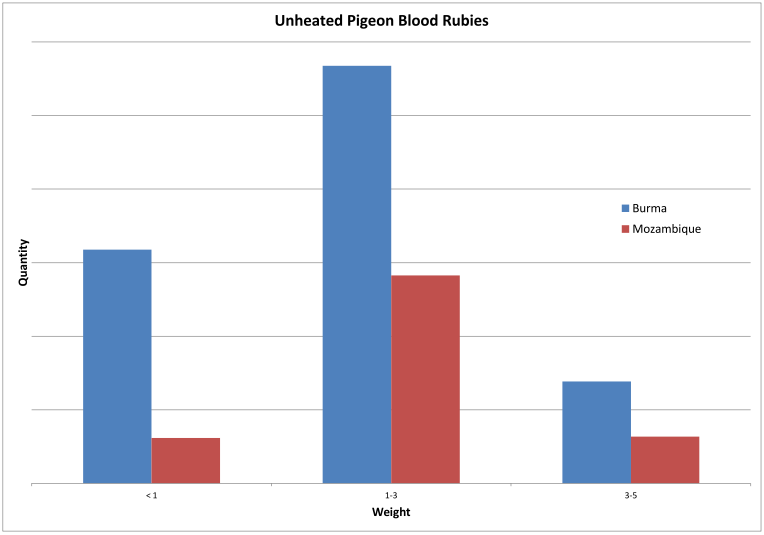A review of beauty and rarity of Mozambique ruby
From today’s perspective, it would be impossible to overstate the significance of African rubies in the gemstone trade. East African ruby, specifically from Mozambique, Tanzania and Madagascar, has recently dominated the market for several reasons; lack of thermal enhancement, brilliancy, size and for its color. No other geographical region has successfully competed with Mozambique ruby with regard to quality and size. Rubies have been found in Mozambique since the Portuguese colonial era from 1498-1975, although producing nothing comparable to today’s quality ruby findings. Mozambique has also become known for its copper-bearing “Paraiba type” tourmaline, rivaling those from Brazil.
Localities of Occurrence
The discovery of new ruby deposits in Niassa and Cabo Delgado province created somewhat of a stir, attracting even miners from dwindling mines bordering on Tanzania, and created a production rush previously unseen in Mozambique. It wasn’t long before this discovery forged a relevant contribution in the gemstone industry. It should be noted that Mozambique ruby fought a tough battle for acceptance in well-established markets against more traditionally desirable provenances like Burma (Myanmar). It was initially thought that there would result a market-flood of unheated ruby which would compromise the rarity of the rubies. It was soon apparent that this would not be the case. Time revealed that the attributes most coveted in the industry would be a dominance of beauty, appearance and size, rather than just its provenance. Additionally, the steady production re-energized the industry’s taste for rubies, creating an increase in demand that has been reflected in its price. Finally, when most of the top Burmese stone dealers began to seriously invest in Mozambique ruby two years ago, the preciousness and acceptance of these rubies could not be questioned anymore.
Attributes of Mozambique Quality
With the existence of the right chemical composition and fluorescence in a good portion of Mozambique ruby, the stunning vivid-red appearance combined with high-clarity produced the equivalent of the finest Burmese colors. Today, the most sought after Mozambique rubies are of unheated GRS type Pigeon’s Blood color, of large size and fine clarity, and are unparalleled in the world of rubies. GRS confidently predicted that Mozambique ruby will continue to ascend to prominence as a landmark ruby occurrence within gemstone history that will not wane (See Preface Tiancheng Auction Catalogue Hong Kong -15 June 2013).


Fig 1 & 2. show the distribution of faceted gem-quality Pigeon’s Blood rubies certified by GRS since 2000 (size categories see X-axis). The number of stones observed in each size category is represented by a bar (no exact number for GRS privacy). Note the large amount of small sized and the scarcity of large ruby sized over 20ct. Gem quality unheated Pigeon’s Blood rubies from Mozambique are rarer than Burmese rubies. This ratio may change as the Burmese mines are mostly exhausted and the Mozambique ruby production has been excelled by foreign investments. However, it may also not change. However, it may also not change. In that case Mozambique rubies will remain rarer than Burmese rubies.
Future Expectations
In its initial production phase, the Mozambique mines yielded almost exactly the same stone size categories as unheated Burmese Pigeon’s Blood rubies (see figure). Today however, the inflow of new large-sized Mozambique ruby to the GRS Laboratory has dramatically decreased. Therefore it must be assumed that large Mozambique ruby rough are extremely rare in comparison to their Burmese counterpart. The GRS statistic shows that the total number of unheated GRS type vivid red Pigeon Blood rubies from Mozambique is smaller than those from Burma (viewed as today’s snapshot – see graph). As is often the case with new mining areas, the initial scenario appeared differently. The first year’s findings are usually the most important and can rarely be duplicated. Future marketing for the Mozambique brand is anticipated from heavy investment by foreign investors into this mining area. It will ensure that the new Mozambique brand of ruby survives and might eventually be on par with the volume of Burmese rubies available. However, there’s no absolute certainty; another scenario may emerge with Mozambique ruby proving it rarer than Burmese ruby. Future promotional initiatives accompanying this ruby production will include ethical mining and fair trade practices, thus generating a positive image for this gemstone source. It can only be viewed as a wonderful ad-on to the beauty and intrinsic magnificence of the gemstone itself.
Dr. A. Peretti
Director GRS Laboratories

|

|

|

|
© 2023, GRS GemResearch Swisslab AG

